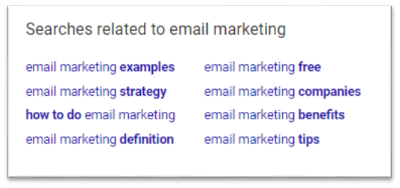
Ever wonder why your website conversions aren’t growing despite increased traffic?
Generally speaking, organic visitors are more likely to convert because they’re more targeted than any other source of traffic.
According to Eric Siu, SEO leads have a 14.6 percent close rate, while outbound leads (such as direct mail or print advertising) have only a 1.7 percent close rate.
That being said, more organic traffic doesn’t always equal more conversions.
A few common reasons for that include:
- Your organic traffic is unqualified.
- Your brand isn’t trustworthy.
- Your offer isn’t compelling.
- Your site isn’t optimized for driving more conversions.
Let’s take a detailed look at these common problems, and how you can fix them.
1. Your organic traffic is unqualified.
Are you targeting short keywords that have millions of searches per month? While that might seem like a good strategy to attract a lot of traffic, that traffic usually won’t do you as much good as you think.
If you’re looking to drive qualified organic traffic to your site that will actually convert, you need to focus on ranking your site for relevant long tail keywords.
Long tail keywords are typically three or four keyword phrases that are very specific to what you’re selling.
Users who type long tail keywords on Google are generally more qualified because they have a clear idea about what they want. Even though the keyword volume for such keywords might be lower, ranking for those keywords ensures that you’re attracting the traffic that’s more likely to convert.
There are many ways to find long tail keywords for your site.
- Look at the related search queries below the Google search result.

- Look for the keyword suggestions in Google when you type.

- Use Google AdWords Keyword Planner by leveraging include and exclude functions.
- Use a keyword research tool like Answer the Public or SEMrush.
2. Your brand isn’t trustworthy.
Repeat visitors often trust or distrust a brand based on their prior experience with that brand.
That means you can earn the trust of your visitors over time by delivering exactly what you promise and consistently satisfying their needs through online marketing channels like email marketing.
But how can you gain the trust of your first-time visitors?
You can rely on various trust factors that make you seem more authoritative and trustworthy. Here are a few trust factors you can rely on:
- Customer reviews: To gain trust, rather than talking about yourself, let your customers talk about you by publishing testimonials on your site. By using testimonials, WikiJob successfully increased their conversions by 34 percent.
- Publish case studies: Case studies show your customers how you’ve helped other people just like them. This helps you to earn the trust of your visitors and convince them to become your customer.
- Trust badges: Using trust badges is another great strategy that is proven to boost conversions. From Crazy Egg’s graph below, it’s clear that including a trust mark on your site is more effective for building trust than creating a professional looking design.

You should also encourage new website visitors to stay connected with you by joining your email list.
3. Your offer isn’t compelling.
If you’re not a first-entry to market, one of the biggest challenges you’ll need to tackle is to make your product stand out from your competition. To do that, you need to understand the real reasons a customer purchases your product.
For example, when we first launched WPForms, our goal was to make it the most beginner friendly contact forms plugin in market.
Instead of going with a feature first mindset, we built it with UX first mindset because the market has already been well served by a feature-rich plugin, Gravity Forms. Going with a UX-first mindset clearly differentiates our product from the rest.

If you’re looking to create compelling offers, you need to find solutions to questions like: Who do you sell your products or services to? What problem does your product solve, and How do you do it better than your competition?
If you can’t set yourself apart from your competition, your offer won’t be compelling enough to make sales.
4. Your site isn’t optimized for conversions.
Increasing traffic without A/B testing your site is like pouring water into a bucket with a hole. Just as a leaky bucket can’t hold water, your website can’t succeed if you’re not focused on fixing the loopholes in your website conversion funnel.
How can you start conversion optimization in the first place?
Here are a few tools to help:
- Google Optimize: Google Optimize is a free A/B testing and personalization product by Google. It lets you easily conduct experiments to see what works best on your site.
- OptinMonster: The best lead generation tool on the web, OptinMonster allows you to test your lead generation forms to boost conversions.
- Crazy Egg: It’s one of the best-known heat map tools available. It tells you how visitors click and scroll through your website.
To get started with testing, come up with a hypothesis to test against your current website and check if they boost conversions.
That means instead of blindly making changes on your site based on your assumptions, you can test them to understand whether they can bring a positive impact.
Ready to boost your website conversions?
Increasing your conversions isn’t easy. It takes time and perseverance to build a strategy that can generate conversions.
But by following the above tips, you’ll avoid some common pitfalls and effectively encourage your website visitors to purchase your products.
Looking for more online marketing tips? Sign up for our newsletter! Our Hints & Tips newsletter delivers our best marketing resources straight to your inbox.
About the Author:
Syed Balkhi is the founder of WPBeginner, the largest free WordPress resource site. With over 10+ years of experience, he’s the leading WordPress expert in the industry.
Syed is also the founder of several popular software companies such as OptinMonster, WPForms, MonsterInsights, and others that help small businesses grow & compete with the big guys. His software runs on over 3 million websites serving billions of impressions every month. You can learn about his suite of companies at the Awesome Motive website.




